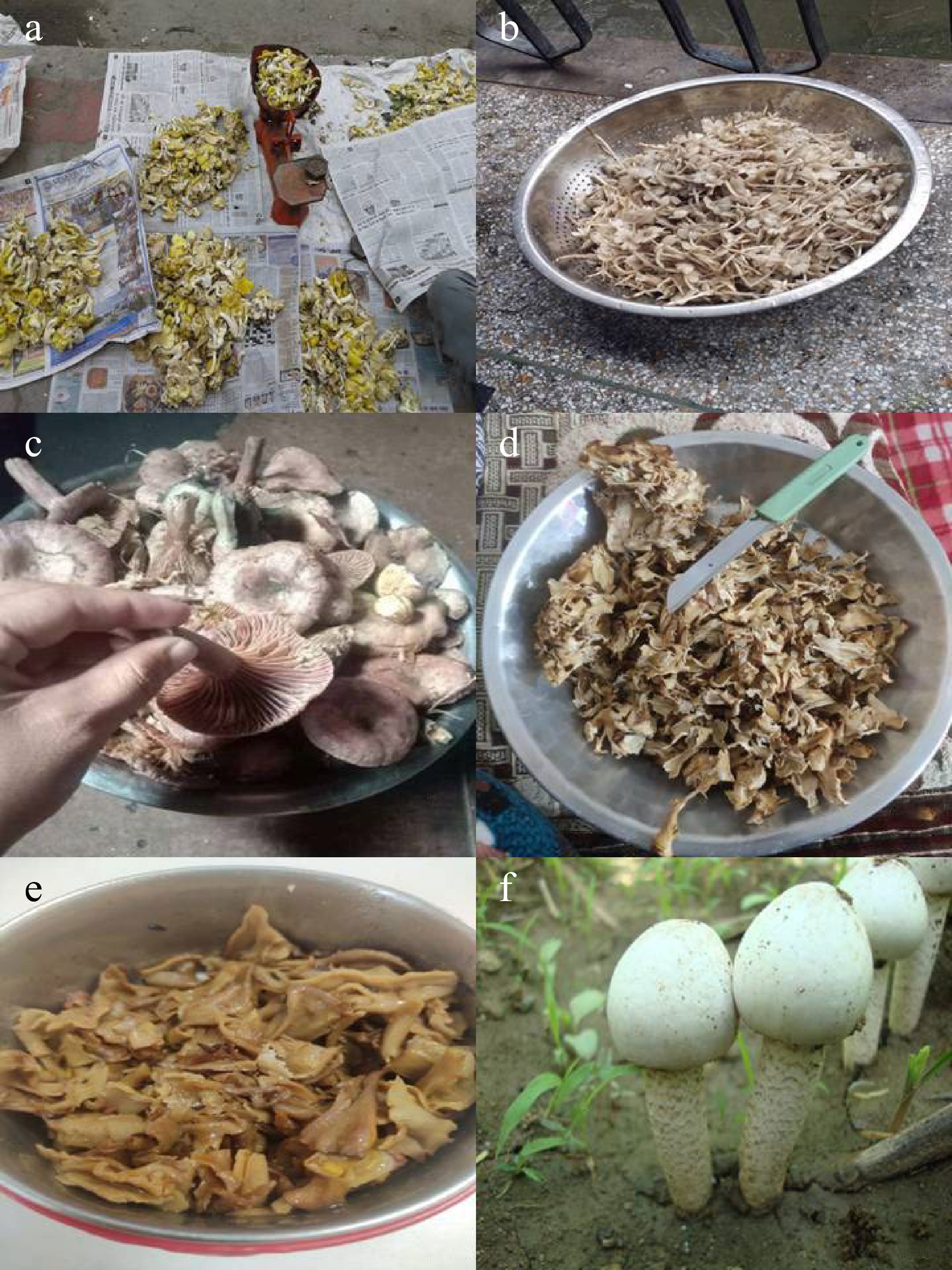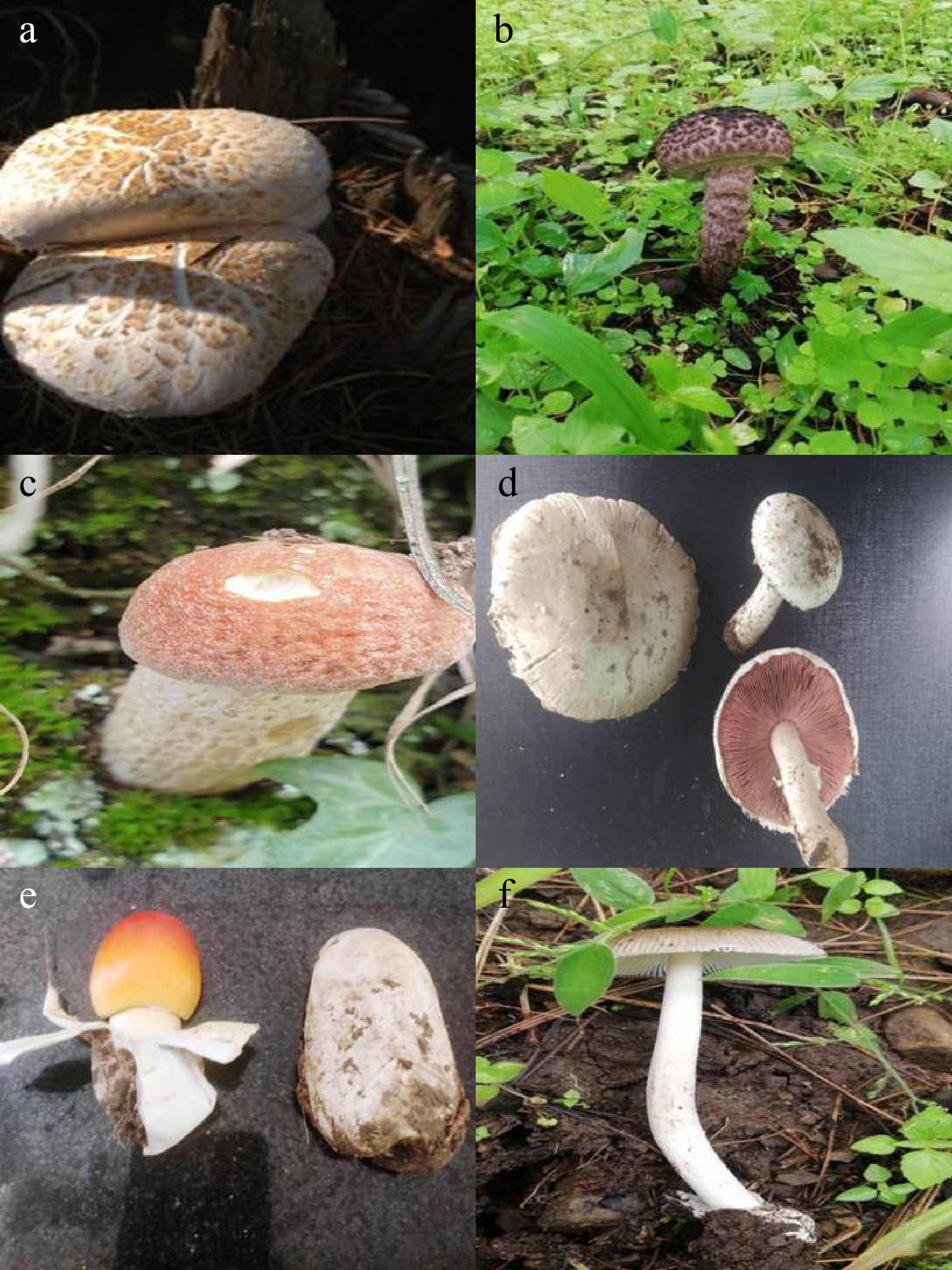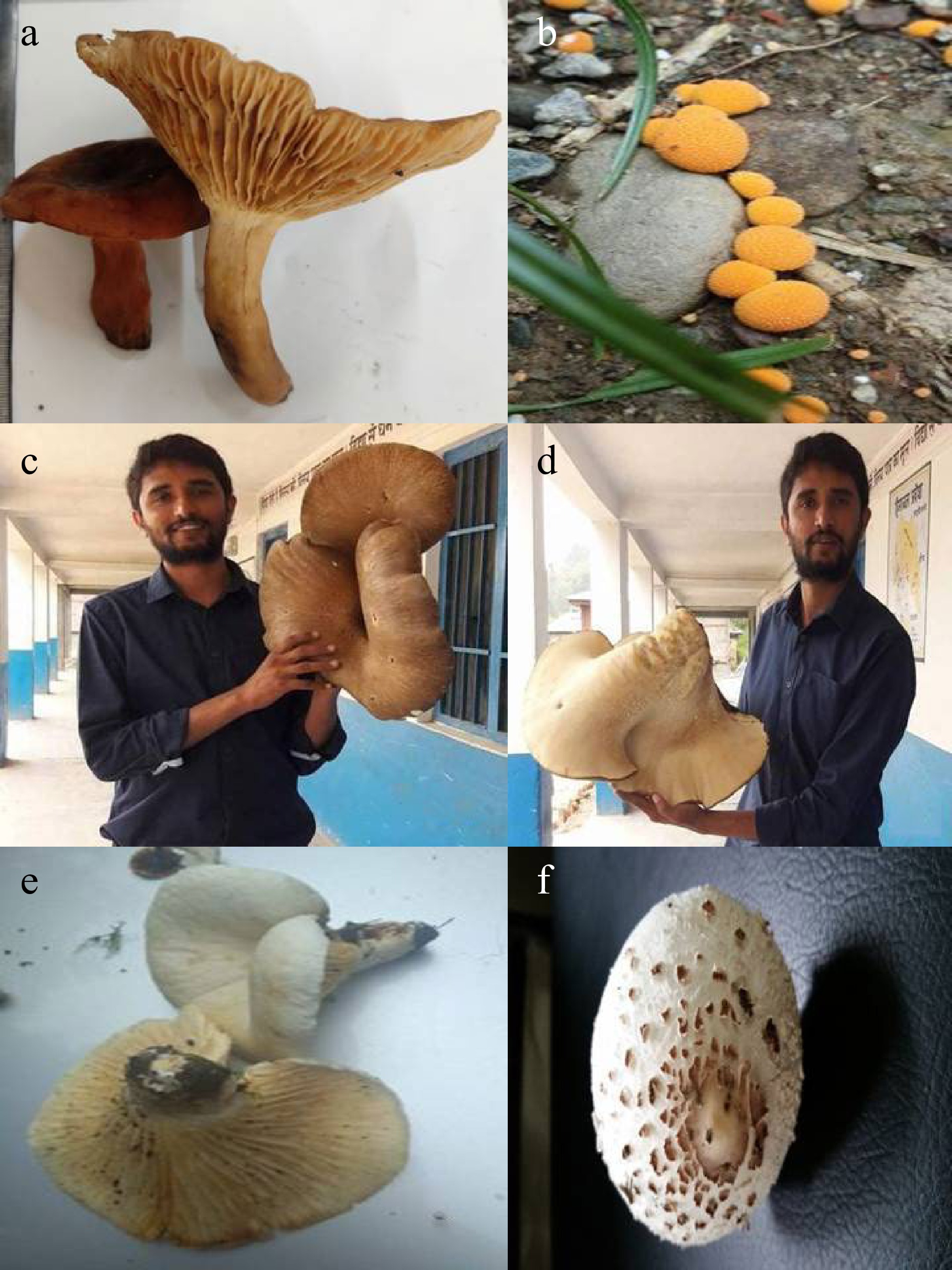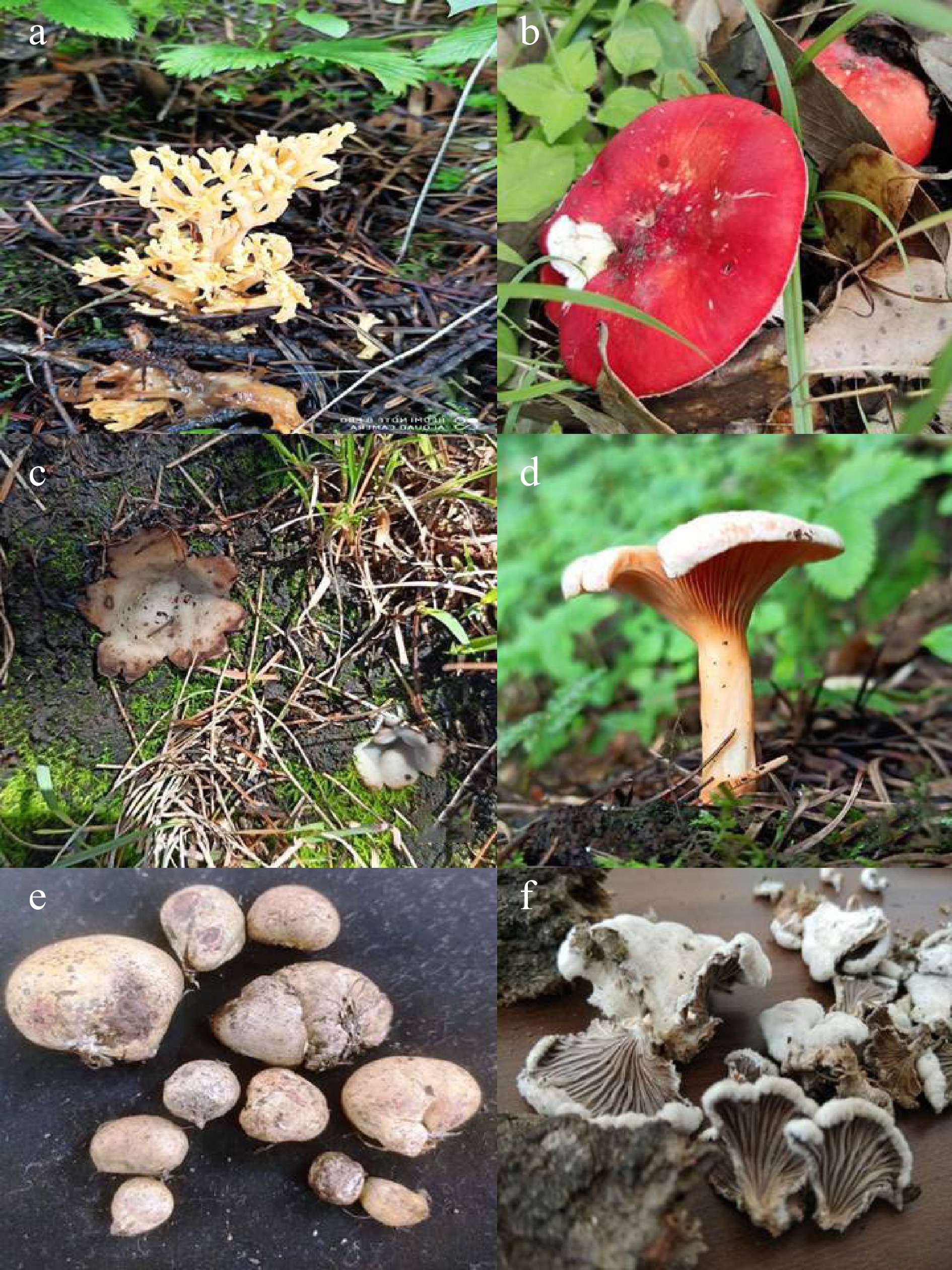-
Himachal Pradesh is located in North West region of the Himalayas and is enriched with a varied diversity of flora and fauna due to its unique environmental conditions. The state's topography, which includes plains, agricultural landscapes, mountains, and forest regions with diverse habitats such as coniferous forests, mixed forests, alpine or subalpine environments, supports the lush growth of fungal wealth. Due to their health-promoting benefits, mushrooms have been collected and consumed for thousands of years. Himachal Pradesh is one of the richest states for edible mushrooms, where approximately 100 types of edible mushrooms are commonly consumed by tribal people and villagers. These 27 species, which belong to 23 genera, were documented from different sites. Among these, Morchella Dill. ex Pers., Cantharellus Adans. ex Fr., Agaricus L., and Termitomyces R. Heim are a relatively dominant genera that are regularly consumed. All the information regarding traditional knowledge, usage, and cuisine status has been documented in the Performa note book in the field. Several authors have been working on ethno-mycological data on mushrooms from Himachal Pradesh[1−7].
-
Ethno mycology reveals that Himachal Pradesh is rich in diversity, and many wild edible mushrooms are frequently collected by locals, villagers, and mainly Gaddi communities for consumption, sale, and medicinal purposes. Among these, Morchella mushrooms are popular in the region for consumption and sale. Dry Morchella mushrooms are sold in local markets for around 30,000−40,000 rupees per kilogram. Locals consume these mushrooms either fresh or dried. Morchella mushrooms are usually sun-dried on the roofs of houses, on slate roofs, or hanging above wood stoves in the form of garlands, then packed in airtight bags or containers for future use. Various researchers were engaged in this field[8−15]. Collecting and selling mushrooms, especially Morchella sp., is a way of earning a livelihood for unemployed or poor people in the region. In the same way, other mushrooms are also frequently consumed by the local people of Himachal Pradesh. Among these, termitophilic mushrooms are preferred as being of culinary excellence by the villagers of Mandi, Kangra, Hamirpur, and Bilaspur regions of Himachal Pradesh. Elders, women, and children often pick Termitophilic mushrooms in bulk amounts from termitaria. Agaricus campestris mushrooms are mostly collected after rain showers in the late summer in hard soil on open ground, mostly in the lower region of Himachal Pradesh.
Other mushrooms such as Lactarius deliciosus, L. subpurpureus, Sparaciss crispa, Termitomyces heimii, Geopora arenicola, Rhizopogon roseolus, Boletus edulis, Cantharellus cibarius, Lactifluus volemus, Pleurotus citrinopileatus, Lactifluus volemus, Lactifluus piperatus, Amanita caesarea and Amanita vaginata are also quite popular and consumed fresh in upper regions of Himachal Pradesh. Other mushrooms namely Auricularia auricula judae, Agrocybe agereta, Ramaria flava, Russula griseocarnosa, Bovista colorata, Meripilus giganteus, Macrolepiota rachodes, Helvella crispa, Neolentinus ponderosus, Strobilomyces confusus, Bovista colorata, and Meripilus giganteus also serve as food substitutes for villagers and tribes in Himachal Pradesh as well as neighboring provinces[16−21]. There is an urgent need to document or preserve this valuable traditional knowledge about wild edible mushrooms in the region, as well as to conduct extensive exploration trips from every corner of Himachal Pradesh to study its medicinal utilization. Important steps should be taken to preserve this valuable bioresource for future use, and these wild edible mushrooms should be domesticated scientifically with the goal of scaling up and developing a prototype to commercialization. Information about their morphological characteristics based on field observations of wild edible mushrooms are given below (Figs 1−5).

Figure 1.
(a)−(f) Pleurotus citrinopileatus for sale at Kullu Bazzar. (b) & (c) A basket full of harvested tiny termitophilic mushrooms and Lactarius deliciosus, ready for the kitchen. (d) Dried Sparassis crispa for cooking. (e) Sparassis crispa being cooked by villagers. (f) Termitomyces heimii growing in its natural habitat.
1. Pleurotus citrinopileatus (golden oyster mushroom): Fruiting bodies are easily identified in the field by their beautiful yellowish to lemon yellow color, convex shaped with depressed centered cap with whitish decurrent gills and small equal shaped stipe, often growing in clusters on decayed wood or on wooden logs (Fig. 1a).
2. Termitomyces microcarpus: These are tiny white colored fruiting bodies often found near termite mounds in large groups, with convex shaped cap, free creamish gills and small cylindrical shaped whitish stipe (Fig. 1b).
3. Lactarius subpurpureus: Fruiting bodies are easily identified by their vinaceous red colour with vase shaped cap, sticky surface, zones with concentric bands often bruising green, decurrent wine red gills attached to equal shaped stipe (Fig.1c).
4. Sparassis crispa (cauliflower mushroom): Fruiting bodies are spheroid, multilobed, wavy like curly or ribbon like with multi branched, whitish to yellowish like a cauliflower appearance with a common base (Fig. 1d & e).
5. Termitomyces heimii: These can be easily identified in the field by its silky whitish fruiting bodies, pinkish lamellae and whitish stipe with long rooted base buried in the soil (Fig. 1f).
6. Neolentinus lepideus (scaly saw gill, train wrecker): Fruiting bodies are tough, fleshy, whitish cap covered with brownish appressed fibrillose scales, cracking and a margin with veil remnants and crowded, decurrent serrated lamellae and long rooted stipe attached on woody substrate (Fig. 2a).

Figure 2.
(a) Neolentinus lepideus, (b) Strobilomyces confusus, (c) Boletus edulis, (d) fruiting body of Agaricus campestris collected May. (e) Amanita caeserea, (f) Amanita vaginata growing in a pine forest.
7. Strobilomyces confusus (old man of the woods): Fruiting bodies are dark coloured with a woolly surface covered with prominent dark grey to blackish scales and prominent annulus and undersurface poroid with hexagonal shaped pores (Fig. 2b).
8. Boletus edulis (penny bun and porcini mushrooms): These can be easily recognized by its globose penny bun like whitish to yellowish brown fruiting body with undersurface creamish poroid and solid, roughened ridged stipe (Fig. 2c).
9. Agaricus campestris (field mushroom, meadow mushroom): Fruiting bodies can be easily identified in the field by its dome shaped to convex shaped whitish shiny, silky cap with brown gills and white stipe with collapsing annulus (Fig. 2d).
10. Amanita caeserea: These can be easily identified in the field by its orange, tomato red colored egg shaped, dome to convex shaped cap with striated margin and free yellowish gills and stipe with whitish volva (Fig. 2e).
11. Amanita vaginata: Carpophores are initially egg shaped greyish brown with striated margin with central umbo, free whitish gills and long whitish annulate and volvate stipe (Fig. 2f).
12. Lactifflus volemus:
Fruiting bodies can be easily identified by their velvety brownish orange with decurrently gills exudating milky latex and stuffed stipe (Fig. 3a). 
Figure 3.
(a) Lactifluus volemus, (b) rare mushroom Bovista colorata in nature, (c) & (d) a young man collected a big specimen of Meripilus giganteus in Mandi (HP), (e) Lactifluus piperatus, (f) Macrolepiota rachodes.
13. Bovista colorata:
Fruiting body are ball shaped to pear shaped yellowish orange to even brown cap with scaly floccose surface with dusty spore mass inside attached to substrate with rhizomorphs (Fig. 3b). 14. Meripilus giganteus (giant polypore): Fruiting bodies are easily identified in the field by its distinctive giant size, with enormous mass greyish beige to brownish basidome with many hats of circular to semicircular or fan shaped pilei and whitish poroid under surface often found on stumps and trunks near roots of tree (Fig. 3c & d).
15. Lactifluus piperatus (milky cap): Fruiting bodies are glabrous, glossy; velvety convex shaped to funnel shaped whitish with decurrent whitish gills exudating whitish milk and stuffed stipe (Fig. 3e).
16. Macrolepiota rachodes:
Fruiting bodies are large sized with yellowish white cap with greyish brown patches or squamules and annulate cylindrical shaped whitish stipe which often discolouring reddish brown on exposure (Fig. 3f). 17. Helvella crispa (elfin saddle): Fruiting body are irregularly lobed, saddle shaped, creamish, whitish to yellowish with multi lobed, curled margin with fused twisted, ribbed, veined stipe (Fig. 4a).

Figure 4.
(a) Helevella crispa, (b) & (c) fruiting bodies of Morchella elata for consumption purposes, (d) Phaeotremella foliacea, (e) Cantharellus cibarius, (f) Agrocybe agereta.
18. Morchella elata (black morel): Fruiting bodies are conical shaped greyish brown to dark brown with deep ridges, cross ribs and ladder like pattern in cap and hollow whitish stipe (Fig. 4b& c).
19. Phaeotremella foliacea (leafy brain): Fruiting bodies are wrinkled, curled, brain like appearance with convoluted fold, multilobed brownish, rubbery to slippery, with a common base (Fig. 4d).
20. Cantherellus cibarius:
Fruiting bodies are beautifully orange coloured, convex with funnel shaped centre, and decurrent, interveined wrinkled gills and stuffed stipe (Fig. 4e). 21. Agrocybe agerita (popular or chestnut mushroom): It can be easily identified in the field by its robust sized yellowish brown fruiting bodies with cob web like veil and stuffed annulate stipe often grow in clusters on the popular tree (Fig. 4f).
22. Ramaria flava:
Fruiting bodies are lemon yellow to sulphur yellow with dense branches with small multi branches tips with a common base (Fig. 5a). 23. Russula griseocarnosa:
These are beautiful red colored convex shaped fruiting bodies with adnexed gills and whitish stipe (Fig. 5b). 24. Geopora arenicola:
It is characterized by a cream colour cup shaped fruiting body with split edges with regular rays like a lotus flower with an inner shiny whitish surface (Fig. 5c). 25. Lactarius deliciosus (saffron milk cap mushroom): It can be easily identified by its orange coloured; vase shaped fruiting bodies with concentric zonation in the cap and decurrent lamellae and stuffed stipe and red bleeding on exposure (Fig. 5d).
26. Rhizopogon roseolus: Ball to pear shaped greyish to brownish yellow fruiting bodies with a hard gleba texture inside attached with numerous rhizomorphs in the soil (Fig. 5e).
27. Schizophyllum commune:
Fruiting bodies are fan to oyster shaped greyish to brownish wooly, hairy cap with under surface with split, branched gills, often found on wood (Fig. 5f). -
Different surveys were carried out by the authors to document folk taxonomy, ethno-data, medicinal and uses of these mushrooms. Collected specimens were identified according to standard techniques[22]. A well framed questionnaire was completed during face to face interactions with 150 interviewees including elders, women, children and local vendors, whole sellers and mushroom vendors. All the specimens are identified with standard taxonomic identification[22, 23]. Identified specimens are namely Neolentinus ponderosus (O.K. Mill.) Redhead & Ginns, Strobilomyces confusus Singer, Boletus edulis Bull., Agaricus campestris L, Amanita vaginata (Bull.) Lam., Lactarius deliciosus (L. ex Fr.) S.F. Gray, Termitomyces microcarpus (Berk. & Broom) R. Heim, Termitomyces heimii Natarajan, Sparassis crispa (Wulfen) Fr., Lactifluus volemus (Fr.) Kuntz, Bovista colorata (Peck) Kreisel, Meripilus giganteus (Pers.) Karst, Lactifluus piperatus (L.) Roussel, Macrolepiota procera (Scop.) Sing., Helvella crispa (Scop.) Fr., Morchella elata Fr., Auricularia auricula judae (Bull.) J. Schrot and Rhizopogon roseolus (Corda) Th. Fr., Schizophyllum commune Fr., Phaeotremella foliacea (Pers.) Wedin J. C. Zamora & Millanes, Cantharellus cibarius Fr. (Figs 1−5). Their scientific names, vernacular names, families, and uses are given in Table 1.
Table 1. Common wild edible mushrooms consumed, local name and uses in Himachal Pradesh, India.
Sr No. Name Local name Family Uses 1 Pleurotus citrinopileatus Riyochi chhochi (Kullu), Chatrad, Dal ri
chattri, Banottiyan (Mandi)Pleurotaceae Fruiting bodies are used generally as a food, pickle and as pakore. 2 Termitomyces microcarpus Bhatoliyan (Mandi) Bhat koir
(Solan, Sirmaur),Lyophyllaceae As a food, in soup often consumed with rice or pulao. 3 Lactarius subpurpureus Chhachi( Mandi Shimla) Russulaceae Consumed as one of most delicious vegetables in upper parts of Shimla and Mandi. Mushroom vegetable. 4 Sparaciss crispa Bab-bakari (Chamba), gobhi mushroom Sparassidaceae Fruiting bodies are well washed to remove dirt from mushrooms, fried with ingredients and oil, which gives good flavour. 5 Termitomyces heimii Tatmour (Mandi) Lyophyllacaeae One of the tastiest mushroom generally consumed by people of lower regions. 6 Neolentinus ponderosus Dikri (Kullu) Gloephyllalaceae Consumed as a vegetables by hilly region of Shimla, Barot valley of Mandi. 7 Strobilomyces confusus NA Boletaceae Consumed as vegetables. 8 Boletus edulis Khukh Boletaceae Generally consumed by locals of Shimla, Mandi Chamba district of Himachal Pradesh. 9 Agaricus campestris Khukh, Khumb Agaricaecae Fruiting bodies are generally consumed most frequently as a vegetable, pickles, fried roasted mushroom tikka dish. 10 Amanita caesarea Peeli chatri, Peela chayun (Palampur,
Shimla Solan)Amanitaceae Button stages of these mushrooms are generally consumed as vegetable. 11 Amanita vaginata Ghi koit (Shimla, Solan) Amanitaceae Consumed as food. 12 Lactifluus volemus Chachi (Mandi, Shimla) Russulaceae Frequently consumed by people of Shimla and Mandi during the rainy season. 13 Bovista colorata Chachi (Mandi) Agaricaceae Young fruiting bodies are eaten as food in near Bhaderwah border region of Chamba & J&K. 14 Meripilus giganteus Chachi (Mandi) Meripilaceae Giant fruiting bodies are often sliced in to small pieces, pickled, dried, consumed as vegetables by the people of Barot valley of Mandi. 15 Lactifluus piperatus Chachi ,Matoshelle
(Mandi, Shimla),Russulacae Consumed as a vegetable. 16 Macrolepiota rachodes Tamotar (Mandi), Bukka (Kullu) Agaricaceae Consumed as food. 17 Helevella crispa Kanude, Kanifdu, Kanchantu (Chamba, Shimla) Helvellaceae Generally consumed as vegetable. 18 Morchella elata Bhunt, Chumbakanu, (Chamba), Chunchru(Kullu) Dunglu, Chunchru (Kullu, Mandi), Cheau (Shimla) Morchellacae Highly consumed by locals due to its good flavour and its taste and also sold @ INR 30000-40000 per kg and also boiled in milk to strengthen immunity. 19 Cantharellus cibarius Peeli chatri (Mandi), Riaachi(Kullu) Cantharellaceae Consumed as one of favourite mushrooms due to its sweet aroma by people of upper region of Shimla, Solan, Sirmaur and Mandi districts. 20 Agrocybe agereta Koet (Solan) Strophariaceae Young fruiting bodies are eaten by locals of Solan district of Himachal Pradesh. 21 Ramaria flava Siun (Shimla) Gomphaceae Generally consumed as food. 22 Russula griseocarnosa Chachi (Mandi, Shimla) Russulaceae Generally consumed as food. 23 Geopora arenicola Khori, Kanifdu (Chamba) Pyronemataceae Generally consumed by tribes of Chamba region. 24 Lactarius deliciosus (Chhachi/mogsha) Mandi Shimla, Kinnaur Russulaceae This is quite a popular mushroom in upper regions of Himachal Pradesh as delicious mushroom vegetable. 25 Rhizopogon roseolus Buthu, Zhanda (Shimla), Bhubhla (Kullu) Rhizopogonaceae Fruiting bodies are eaten either as a raw, roasted form, or in boiled form. 26 Schizophyllum commune Koet (Solan, Sirmour), Chiyaun(Kullu) Schizophyllaceae Fruiting bodies are boiled in water, consumed as vegetables and in soup form. 27 Phaeotremella foliacea NA Phaeotremellaceae Fruiting bodies are often dried in sunlight for winter use and also used in soup in the Kullu region. -
The authors are grateful to locals, villagers, Gaddi communities for providing information about collection, identification, and utility of these mushrooms and their supportive and helping nature throughout the entire investigation.
-
The authors declare that they have no conflict of interest.
- Copyright: © 2022 by the author(s). Published by Maximum Academic Press, Fayetteville, GA. This article is an open access article distributed under Creative Commons Attribution License (CC BY 4.0), visit https://creativecommons.org/licenses/by/4.0/.
-
About this article
Cite this article
Kumari B, Kamal S, Singh R, Sharma VP, Sanspal V, et al. 2022. Traditional knowledge of the wild edible mushrooms of Himachal Pradesh. Studies in Fungi 7:15 doi: 10.48130/SIF-2022-0015
Traditional knowledge of the wild edible mushrooms of Himachal Pradesh
- Received: 01 February 2022
- Accepted: 28 November 2022
- Published online: 07 December 2022
Abstract: The purpose of the present study is to document traditional knowledge of the wild edible mushrooms of Himachal Pradesh. Ethno-mycological data was recorded from different regions of the state, viz., Barot, Kangra, Shimla, Solan, Sirmaur, Mandi, Kullu, and Gaddi inhabitant regions of Chamba district in Himachal Pradesh, India. The local inhabitants of the region collect these mushrooms from the forests. Experienced members of families and local bodies teach the younger generation about edible and poisonous wild mushrooms, as well as their distribution patterns in forests. The majority of the collected wild edible mushrooms are consumed fresh. In this paper, we have presented the traditional knowledge about collection, identification, and documentation as per the knowledge available among indigenous people.













